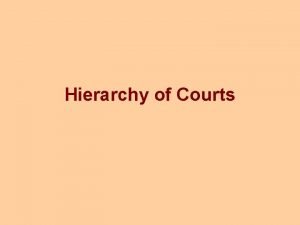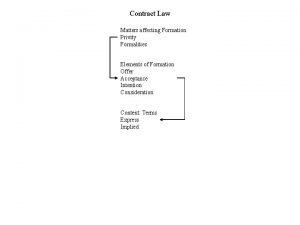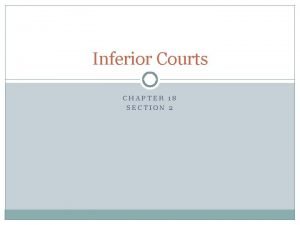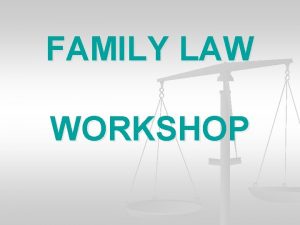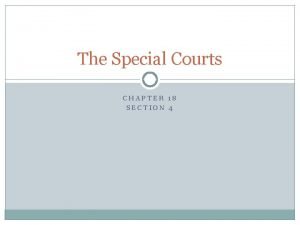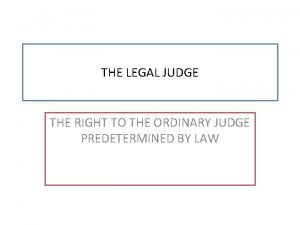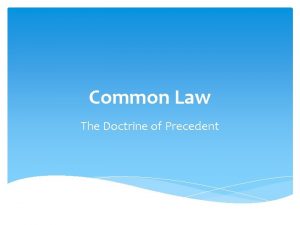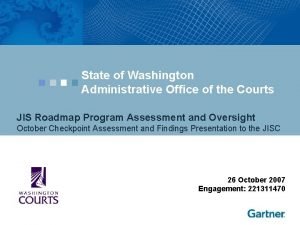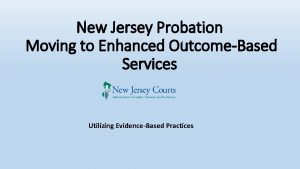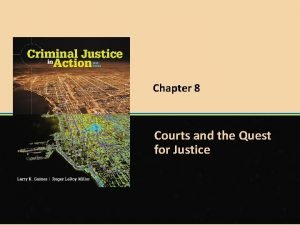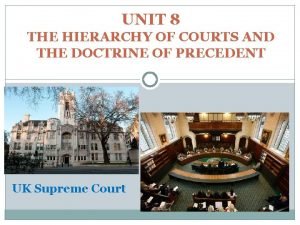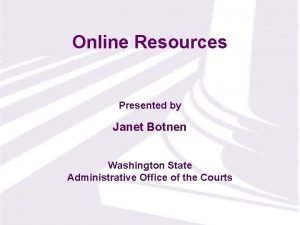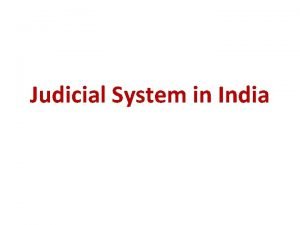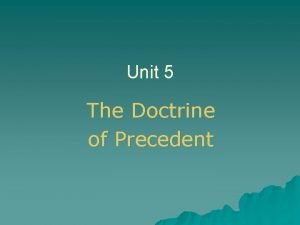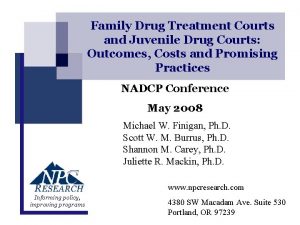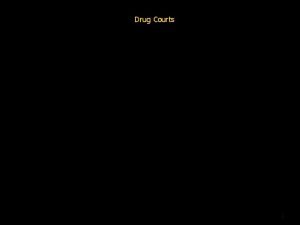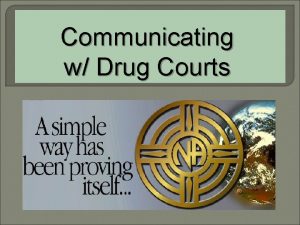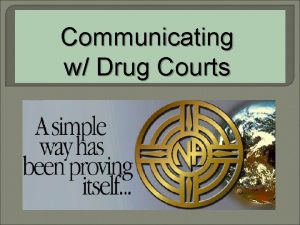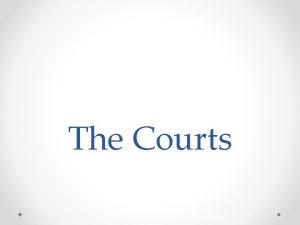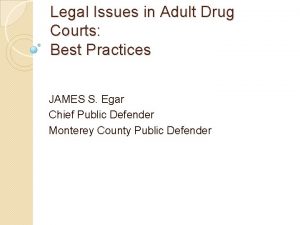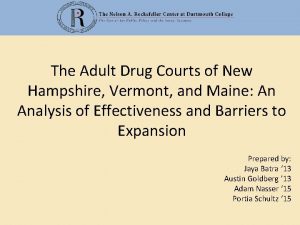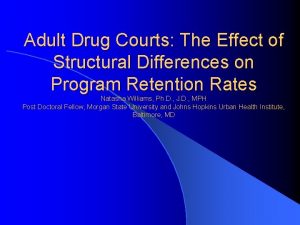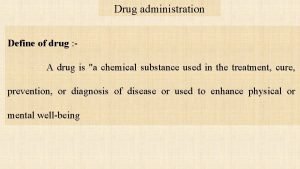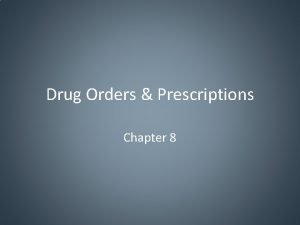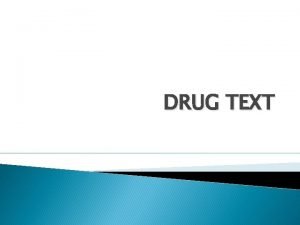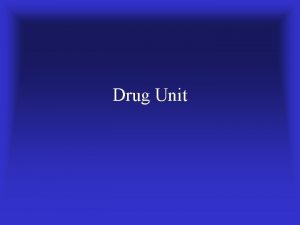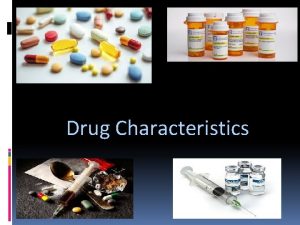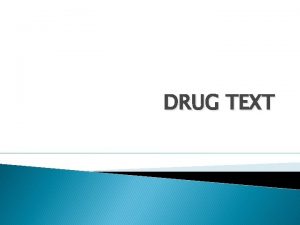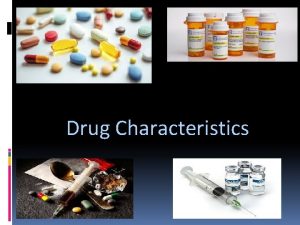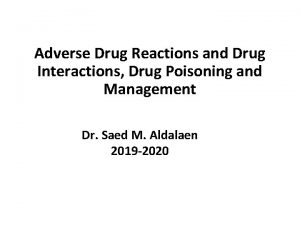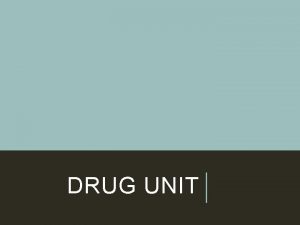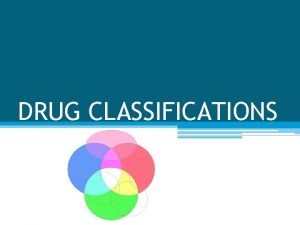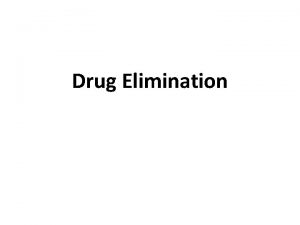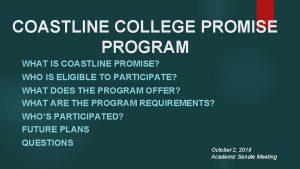The Promise of Drug Courts 23 of Adult
























































- Slides: 56

The Promise of Drug Courts

2/3 of Adult and 1/2 of Juvenile Arrestees Test Positive for Drugs New York City 80% Detroit 78% Philadelphia 76% Indianapolis 63% Oklahoma City 72%

Arrestees Test Positive for Methamphetamine Portland, Spokane, San Diego and Phoenix report 25% to 44%

From 1979 to present date, the number of drug and alcohol users in the United States declined by 45%, but the percentages of burglaries, robberies, murder, and other crime attributable to drugs has spiraled incessantly upward, even as crime in general has declined. We are a nation of fewer addicts, but a nation of more harmful and destructive addicts.


What is our Philosophical Base? Punishment or Rehabilitation

What if we JUST put them in PRISON? 29. 9% of prisoners released in 1998 in 15 states were rearrested within six months and 68% are rearrested within three years. (Bureau of Justice Statistics, 2002) 95% relapse to substance abuse in three years. (Treatment Research Institute, 2002)

The Number of Inmates Released Federal and States Prisons 635, 000 473, 300 1995 2001

Judge Dennis Challeen We want them to have self-worth So we destroy their self-worth We want them to be responsible So we take away all responsibility We want them to be positive and constructive So we degrade them and make them useless We want them to be trustworthy So we put them where there is no trust

Judge Dennis Challeen We want them to be non-violent So we put them where violence is all around them We want them to be kind and loving people So we subject them to hatred and cruelty We want them to quit being the tough guy So we put them where the tough guy is respected We want them quit hanging around losers So we put all the losers in the state under one roof

Judge Dennis Challeen We want them to quit exploiting us So we put them where they exploit each other We want them to take control of their lives, own problems and quit being a parasite on… So we make them totally dependant on us

The Answer “We need to punish the offenders we are afraid of and treat the ones we are mad at” Hon. Dennis Challeen


What if we JUST refer them to TREATMENT? Attrition n 50% to 67% don’t show for intake n 40% to 80% drop out in 3 months n 90% drop out in 12 months Outcomes n 40% to 60% of clients abstinent at 1 year Treatment Research Institute, 2003

“We cannot solve the problems we have created with the same thinking that created them” Albert Einstein


Courts as Problem-Solver “Effective trial courts are responsive to emergent public issues such as drug abuse…A trial court that moves deliberately in response to emergent issues is a stabilizing force in society and acts consistently with its role of maintaining the rule of law” Bureau of Justice Assistance’s Trial Court Performance Standards, 1997

Unlike These Judges

Drug Court Judges Find the Good in Those Who Can’t See it in Themselves


Painting the Current Picture: A National Report Card on Drug Courts and Other Problem-Solving Courts in the United States Volume I, Issues 1 and 2 C. West Huddleston Hon. Karen Freeman-Wilson Doug Marlowe, Ph. D. , J. D. Aaron Roussell Office of National Drug Control Policy, Executive Office of the President and the Bureau of Justice Assistance, U. S. Department of Justice

Drug Courts: A National Phenomenon

Number of Drug Courts 1989 1 1990 1 1991 5 1992 10 1993 19 1994 40 1995 75 1996 139 1997 230 1998 347 1999 472 2000 665 2001 847 2002 1, 048 2003 1, 183

1, 621 Drug Courts in 2004 1, 621 Drug Courts in Operation 811 Adult Drug Courts 357 Juvenile Drug Courts 153 Family Dependency Treatment Courts 176 DWI Courts (90/86) 54 Tribal Healing to Wellness Courts 68 Reentry Drug Courts 1 Campus Drug Court 1 Federal Drug Court

2004 Drug Court Activity 37% Increase from 2003 16, 186 graduates in 2004 69, 000 currently being served 75% of Adult Drug Courts are Post Plea

Benefits of Drug Court “drug courts provide the most comprehensive and effective control of drug-using offenders’ criminality and drug usage while under the court’s supervision. ” -Effective Treatment-Drug Testing-Community Supervision and Structure. Belenko (1998; 2001)


Effective Community Supervision and Home Visits

Bar Sweeps


Benefits of Drug Courts Increase Retention in Treatment

Treatment Research Findings Drug Abuse Reporting Project (DARP) ü Treatment Outcome Prospective Study (TOPS) ü Drug Abuse Treatment Outcome Study (DATOS) ü National Treatment Improvement Evaluation Study ü

Treatment Research Findings n The length of time a patient spent in treatment was a reliable predictor of his or her post treatment performance. Beyond a ninety-day threshold, treatment outcomes improved in a direct relationship to the length of time spent in treatment, with one year generally found to be the minimum effective duration of treatment. n Coerced patients tended to stay longer. This was in light of the finding that most of the legally coerced addicts had more crime and gang involvement, more drug use, and worse employment records than their non-coerced counterparts.

Retention in Treatment “Drug Courts exceed these abysmal projections”… “This represents a sixfold increase in treatment retention over most previous efforts. ” Marlowe, Dematteo, & Festinger, 2003

Benefits of Drug Court: Drug Courts Reduce Criminal Involvement

Graduation is KEY “The body of literature on recidivism is now strong enough to conclude that completing a drug court program reduces the likelihood of further involvement in the criminal justice system. ” Vera: Fluellen & Trone,

National Research 2020 Graduates from 95 Drug Courts Representing 17, 000 Graduates 1 Year Post Graduation: 16. 4% 2 Years Post Graduation: 27. 5% Roman, Townsend & Bhati,

Statewide Research “Re-conviction rate among a sample of almost 2, 500 drug court participants in six sites across New York State was, on average, 29% lower (56% to 40%) over three years after the initial arrest than the comparison group. Repel, et. al. 2003

GAO Evaluation Review Drug court participants had: Lower rearrest and reconviction rates than comparison group members. Fewer recidivism events/incidents than comparison group members. Longer time intervals until rearrest or reconviction than comparison group members. Recidivism reductions in various categories of offenses Decreased involvement in substance abuse Positive cost/benefit/ratio GAO, 2005

Benefits of Drug Court: Drug Courts Save Money

Drug Courts Save Money “A state taxpayer’s return on the upfront investment in drug courts is substantial. ” ”a county’s investment in drug court pays off. ”

Statewide Research “New York Statewide Drug Court System saved $254 Million in three years” Rempel et al, 2003

Statewide Research “The average drug court participant produces $6, 779 in benefits with $3, 759 in avoided criminal justice costs paid by taxpayers and $3, 020 in avoided costs to victims. ” 2003 Washington State Institute for Public Policy,

Statewide Research “California drug courts demonstrate a savings of 18 million per year. A 14 million investment returned 43. 3 million in savings over two years. ” Judicial Council of California 2002; NPC Research & Judicial Council of California

Local Research “In St. Louis, Missouri, each drug court graduate cost the city $2, 615 less than those on probation alone. ” Institute for Applied Research, 2004

Local Research “For every dollar spent on drug court in Multnomah County, Oregon, ten dollars were saved. ” Finigan, 1998 “A total savings to the local taxpayer over a thirty-month period was $5, 071. 57 or a savings of $1, 521, 471 per year. ” Carey & Finigan,

Local Research “For every dollar spent on drug court in Dallas, Texas, $9. 43 in tax dollars was realized over a forty-month period. ” Fomby & Rangaprasad, 2002

Cost Benefits of Drug Court Avoided Criminal Justice Costs Avoided Victim Costs Employability Drug Free-Babies

460 drug free babies in 2004!

“To put it bluntly, we know that drug courts outperform virtually all other strategies that have been attempted for drug-involved offenders. ” Marlowe, De. Matteo, Festinger (2003)

National Resolutions “Continued development of problem-solving courts” American Bar Association, 2001 “To take steps nationally and locally to expand the methods and principles of wellfunctioning drug courts into ongoing court operations” Conference of Chief Justices and the Conference of Court Administrators, 2000/2004

National Resolutions The National District Attorneys Association The National Sheriffs Association International Association of Chiefs of Police The National Association of County Organizations Governors Highway Safety Association Mothers Against Drunk Driving

Drug Court Permutations “Problem Solving in the Courts: Taking the Model to Other Populations”

936 Problem-Solving Courts Teen Courts – 393 Mental Health Courts - 111 Domestic Violence Courts – 141 Community Courts - 23 Reentry Courts – 16 Gun Courts- 2 Prostitution Courts - 4 Parole Violation Courts - 5 Homeless Courts - 6 Truancy Courts - 131 Child Support Courts – 45 Integrated Courts 17 Other -42

Number of Operational Problem-Solving Court Programs in the United States 1, 667 - 2003 2, 557 - 2004

Aiming to Solve the Problems of the People Who Come Before the Courts is Work Worth Doing!
 Types of adulteration of crude drugs
Types of adulteration of crude drugs Jurisdiction of high court
Jurisdiction of high court When will the courts imply terms into a contract
When will the courts imply terms into a contract The inferior courts chapter 18 section 2
The inferior courts chapter 18 section 2 Family law facilitator
Family law facilitator Courts hierarchy
Courts hierarchy Chapter 18 section 4 the special courts worksheet answers
Chapter 18 section 4 the special courts worksheet answers The indolent judge
The indolent judge Doctrine of precedent
Doctrine of precedent Uk courts hierarchy
Uk courts hierarchy Washington administrative office of the courts
Washington administrative office of the courts New jersey courts
New jersey courts Hierarchy of english courts
Hierarchy of english courts Tennis courts wolverhampton
Tennis courts wolverhampton Hold thy desperate hand
Hold thy desperate hand 4 levels of state courts
4 levels of state courts British court hierarchy
British court hierarchy Judicial restraint clipart
Judicial restraint clipart Inside courts wa
Inside courts wa 3 types of courts in india
3 types of courts in india Court hierarchy
Court hierarchy Fare program az state courts
Fare program az state courts British court hierarchy
British court hierarchy Các số nguyên tố là gì
Các số nguyên tố là gì Vẽ hình chiếu vuông góc của vật thể sau
Vẽ hình chiếu vuông góc của vật thể sau Các châu lục và đại dương trên thế giới
Các châu lục và đại dương trên thế giới Thang điểm glasgow
Thang điểm glasgow Thế nào là hệ số cao nhất
Thế nào là hệ số cao nhất ưu thế lai là gì
ưu thế lai là gì Hệ hô hấp
Hệ hô hấp Tư thế ngồi viết
Tư thế ngồi viết Cái miệng nó xinh thế chỉ nói điều hay thôi
Cái miệng nó xinh thế chỉ nói điều hay thôi đặc điểm cơ thể của người tối cổ
đặc điểm cơ thể của người tối cổ Mật thư anh em như thể tay chân
Mật thư anh em như thể tay chân Bổ thể
Bổ thể Tư thế ngồi viết
Tư thế ngồi viết Thẻ vin
Thẻ vin Thể thơ truyền thống
Thể thơ truyền thống Chúa yêu trần thế
Chúa yêu trần thế Các châu lục và đại dương trên thế giới
Các châu lục và đại dương trên thế giới Từ ngữ thể hiện lòng nhân hậu
Từ ngữ thể hiện lòng nhân hậu Diễn thế sinh thái là
Diễn thế sinh thái là Vẽ hình chiếu vuông góc của vật thể sau
Vẽ hình chiếu vuông góc của vật thể sau Thế nào là giọng cùng tên
Thế nào là giọng cùng tên 101012 bằng
101012 bằng Tỉ lệ cơ thể trẻ em
Tỉ lệ cơ thể trẻ em Lời thề hippocrates
Lời thề hippocrates Khi nào hổ mẹ dạy hổ con săn mồi
Khi nào hổ mẹ dạy hổ con săn mồi đại từ thay thế
đại từ thay thế Quá trình desamine hóa có thể tạo ra
Quá trình desamine hóa có thể tạo ra Công thức tính độ biến thiên đông lượng
Công thức tính độ biến thiên đông lượng Thế nào là mạng điện lắp đặt kiểu nổi
Thế nào là mạng điện lắp đặt kiểu nổi Hát kết hợp bộ gõ cơ thể
Hát kết hợp bộ gõ cơ thể Dot
Dot Thế nào là sự mỏi cơ
Thế nào là sự mỏi cơ Vẽ hình chiếu đứng bằng cạnh của vật thể
Vẽ hình chiếu đứng bằng cạnh của vật thể Phản ứng thế ankan
Phản ứng thế ankan

